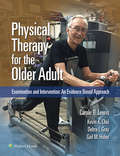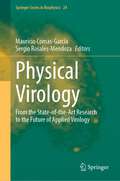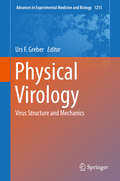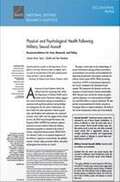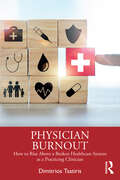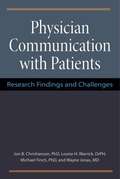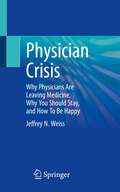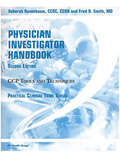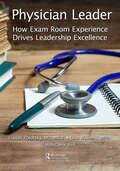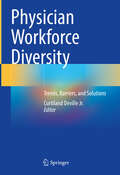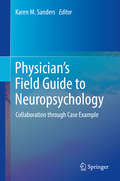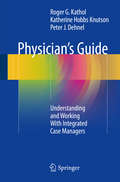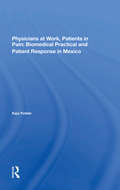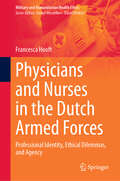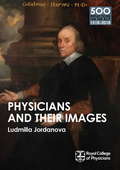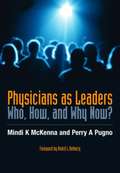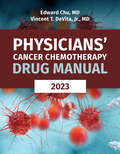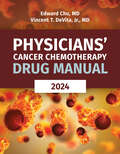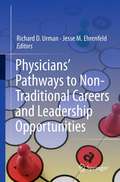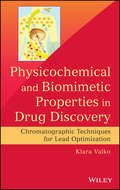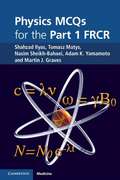- Table View
- List View
Physical Therapy for the Older Adult: Examination and Intervention: An Evidence Based Approach
by Carole LewisProviding a comprehensive, evidence-based overview of physical therapy for older adults, this text integrates physical therapy concepts, evaluations, interventions, and clinical examples with supporting videos and interactive learning assessments. Taking full advantage of the electronic format, Physical Therapy for the Older Adult follows a standard chapter outline, beginning with online quizzes that set the stage for students, then moving into content, cases, and In-depth case videos. Every chapter has a beginning, middle and ending activity that gets students and practitioners thinking about the information to come and how to integrate new ideas into clinical practice. Carole Lewis, recipient of the 2016 Mary McMillan Lecturer Award, brings her experience and expertise to this critical topic along with renowned co-editors and authors from across the country.
Physical Virology: From the State-of-the-Art Research to the Future of Applied Virology (Springer Series in Biophysics #24)
by Sergio Rosales-Mendoza Mauricio Comas-GarciaThis book highlights key findings generated during the past years from the main disciplines that constitute Physical Virology, from theoretical physics and simulations to material sciences and vaccines development to structural biology. Each chapter is written by world-class scientists from these areas and is a comprehensive review of where this field stands, as well as the future of Physical Virology. The diversity in the formal training of these scientists results in solving common problems using very distinct approaches, which can produce surprising findings. The multi- and interdisciplinary nature of this field has created a remarkable community that aims at understanding how viruses work and how they can be used in material sciences, chemistry, and biomedicine. Furthermore, the development of Physical Virology has resulted in technological advances that have shaped other fields; for example, it would be impossible to think about the development of Cryo-EM to solve the structure of complex viruses with atomic resolution without the contribution of scientists that created the field of Physical Virology. In the past decade, there has been a great success in the generation of viral systems that can encapsulate drugs, non-viral genetic material, or nanoparticles, as well as in the chemical and genetical modification of virions. Without any doubt in the immediate future, some of these technologies will jump from the bench to the market, creating a revolution in translational and biomedical sciences. The book provides key perspectives for the field, derived from expert´s opinions.
Physical Virology: Virus Structure and Mechanics (Advances in Experimental Medicine and Biology #1140)
by Urs F. GreberThis book explores a new challenge in virology: to understand how physical properties of virus particles (virions) and viruses (infected cells) affect the course of an infection. Insights from the emerging field of physical virology will contribute to understanding of the physical nature of viruses and cells, and will open new ways for anti-viral interference.Nine chapters and an editorial written by physicists, chemists, biologists and computational experts describe how virions serve as trail blazers in uncharted territory of cells. The authors outline how particles change in composition as they interact with host cells. Such virus dynamics are crucial for virus entry into cells and infection. It influences the modern concepts of virus-host interactions, viral lineages and evolution. The volume gives numerous up-to-date examples of modern virology and provides a fascinating read for researchers, clinicians and students in the field of infectious diseases.
Physical and Biological Barriers at the Interface Between the Gut Microbiome and the Immune System (The Microbiomes of Humans, Animals, Plants, and the Environment #5)
by Marika Falcone Martina Antonini CencicchioThe gut environment is fundamental to the modulation of innate and adaptive immunity, not only in the intestinal mucosa, but systemically. Immune cells constantly circulate through the intestinal tissue and gut-associated lymphoid tissue (GALT), where their phenotype and function are regulated by several factors, including but not limited to the commensal gut microbiota. The host-microbiome interaction, and the role of the gut microbiota in modulating innate and adaptive immunity in the intestinal mucosa and systemically, has been amply described in recent literature and reviews. This contributed volume instead explores the cutting-edge concept that gut microbiota composition is only one of the actors in intestinal immune regulation, and that several other factors -- both genetic and environmental -- modulate innate and adaptive immunity within the intestine. Each chapter in this volume addresses the various intestinal factors modulating immunity, including food components, endogenous metabolites, biological gut barrier components, and enteric neuroimmune circuits, individually and within the context of their integration with systemic components affecting immune cell phenotypes and function. In addition, it will more broadly address the role of the physical and biological barriers as key players in the interaction between immune cells and the intestinal environment, including coverage of cutting-edge in vivo technologies that have allowed the characterization of these interactions. The final chapters are dedicated to understanding how gut environment modifications are involved, and can be therapeutically manipulated in different diseases settings, including targeting the gut environment to regular response in anti-tumor immunity, fighting infections, and controlling autoimmune diseases.
Physical and Psychological Health Following Military Sexual Assault: Recommendations for Care, Research, and Policy
by Terri Tanielian Terry L. Schell Coreen FarrisThis paper reviews data on the prevalence of sexual assault among servicemembers, predictors of disclosure, efforts to improve disclosure, victim needs and DoD efforts to provide necessary resources in the immediate aftermath of a sexual assault. The authors compared civilian and DoD guidelines for care and found them to be generally consistent. However, little is known about the fidelity with which DoD recommendations are implemented.
Physician Assisted Suicide: Expanding the Debate (Reflective Bioethics)
by Anita Silvers Rosamond Rhodes Margaret P. BattinPhysician Assisted Suicide is a cross-disciplinary collection of essays from philosophers, physicians, theologians, social scientists, lawyers and economists. As the first book to consider the implications of the Supreme Court decisions in Washington v. Glucksburg and Vacco v. Quill concerning physician-assisted suicide from a variety of perspectives, this collection advances informed, reflective, vigorous public debate.
Physician Burnout: How to Rise Above a Broken Healthcare System as a Practicing Clinician
by Dimitrios TsatirisPhysician Burnout: How to Rise Above a Broken Healthcare System as a Practicing Clinician is a comprehensive self-help guide that provides practical strategies based on groundbreaking research to help physicians overcome burnout.Written by a board-certified psychiatrist who provides mental healthcare to physicians, this book is rich in pragmatic, evidence-based strategies to help the reader be better equipped to navigate the daily rigors of practicing medicine. It contains countless clinical examples that illustrate how to overcome burnout and rise above the ever-complex and fragmented landscape of the U.S. healthcare system.In addition, this book examines how the healthcare system contributes to physician suffering and provides recommendations for improving the culture of medicine.This book is an essential read for physicians and trainees suffering from burnout as well as anyone who cares about the future of medicine.
Physician Communication with Patients: Research Findings and Challenges
by Michael Wayne Finch Jonas Christianson Jon B. Warrick Louise H.We all have a good idea of how we want things to go when we visit a physician. We expect to be able to explain why we are there, and we hope the physician will listen and possibly ask questions that help us clarify our thoughts. Most of us hope that the physician will provide some expression of empathy, offer a clear, nontechnical assessment of our problem, and describe "next steps" in a way that is easy to understand. Ideally, we would like to be asked about our ability to follow treatment recommendations. Some experts say that these expectations are not only reasonable but even necessary if patients are to get the care they need. Yet there is a growing body of research that suggests the reality of physician communication with patients often falls short of this ideal in many respects. A careful analysis of the findings of this research can provide guidance to physician educators, health care administrators, and health policy makers interested in understanding the role that improved physician communication can play in improving quality of care and patient outcomes. Physician Communication with Patients summarizes findings from the academic literature pertaining to various aspects of this question, discussing those findings in the context of current pressures for change in the organization and delivery of medical services.
Physician Crisis: Why Physicians Are Leaving Medicine, Why You Should Stay, and How To Be Happy
by Jeffrey N. WeissThis book is the first volume to individually dissect and explore the reasons physicians are leaving medicine. It lays out potential solutions to many of the problems, which will result in a happier practicing physician. Chapters begin with the nature of the problem, and go through a physician's life cycle on the job, from medical school through post-grad and onwards. Chapters will also cover issues as a practicing physician and how to help alleviate these problems. The book ends with potential solutions to the issue of physician burnout. Physician Burnout: Why Doctors Are Leaving Medicine and How to Fix It is a must-have resource for practicing physicians, healthcare providers, and healthcare management. It is also a great resource for medical school students and those looking to get into the healthcare field.
Physician Investigator Handbook: GCP Tools and Techniques, Second Edition
by Fred Smith Deborah RosenbaumA comprehensive guide for physicians conducting clinical research, this second edition addresses a broader research perspective. It includes information on the implications of the ICH Guidelines, current FDA regulations, and an Internet address directory. Everything the clinical trial manager, planner, monitor, and investigator need to know about t
Physician Leader: How Exam Room Experience Drives Leadership Excellence
by Lisa Williams Hanah PolotskyPhysicians are often asked to lead healthcare teams, departments, divisions, practices, and hospitals. Though many of them are experts in their fields, they are rarely prepared or educated in business management and leadership. Based on the authors’ interviews with many physician and non-physician executives and leaders, medical training contributes little to leadership skills. Many physicians leave medical training with a command-and-control leadership style that later has to be unlearned to succeed in a team-based healthcare environment. This book will help physician leaders to shed derailers and authoritarian leadership tendencies picked up in years of medical training. It is intended for (1) physicians who are transitioning to healthcare leadership roles, (2) senior-level physician and non-physician leaders as a coaching model to develop their physician leader direct reports, and (3) administrative leaders who are partnering with physician leaders. Both authors progressed from mid-level leadership roles to the C-suite, one as a physician leader and one as an administrative leader. As such, they have leveraged their operational excellence expertise to design the Iterative Leadership Model that includes the leader’s mindset, Leadership Strategies, and a coaching framework: GUIDES (Gather, Understand, Identify, Design, Execute, and Self-Reflect) that is based on the scientific method, PDSA (Plan, Do, Study, Act), A3 thinking, and the SOAP (Subjective, Objective, Assessment, and Plan) note format. The authors masterfully integrate personal reflections, coaching examples, illustrative fictional vignettes, and GUIDES exercises to support leaders in the self-development and self-improvement of seven critical Leadership Attributes: strategic thinking, effective communication, coaching, team-building, change management, continuous learning, and problem-solving.
Physician Workforce Diversity: Trends, Barriers, and Solutions
by Curtiland DevilleThis book offers a comprehensive summary of the current and historical trends in physician workforce diversity by residency training specialty and demographic identity group. This book serves as a one-stop source for physician workforce diversity from the perspective of training specialties, summarizing trends over time, historical barriers, and specialty specific interventions and solutions. Chapters provide a necessary foundational resource for medical educators seeking to enhance diversity, equity, and inclusion (DEI) in their programs and programming. It similarly supports health system and organizational leaders in understanding the current and historical landscape of DEI across medical specialties and demographic groups to inform their interventions and initiatives in an evidence-based manner. The book is divided into two sections: training specialties and demographic identity groups. In the first section, DEI within several of the largest medical residency training specialties is explored. In the second section, the representation trends of various demographic identity groups, including women and individuals from racial and ethnic minority groups, and deaf and disabled individuals, are discussed, as well as barriers and solutions to improving representation, equity, and inclusion. Each chapter will follow the same format: Relevant specialty- or demographic-specific literature is reviewed, discussing the rationale for workforce diversity and inclusion in that specialty or demographic identity group. Current data by race, ethnicity, sex, and other available demographics is discussed for various trainee and practicing physician categories across the training and professional continuum, such as practicing physicians, academic faculty, graduate medical education residents and fellows, residency applicants, and medical school graduates. Historical demographic trends are assessed over time. This is followed by a thorough discussion of specialty or demographic-specific strengths and weaknesses to DEI and related barriers, impediments, and interventions and solutions. This is an ideal guide for medical educators, department chairs in academia and private/community practice, health system leaders, healthcare organization board members and executive leaders, diversity thought leaders, search committees, and medical students and trainees, especially during their specialty selection process.
Physician's Field Guide to Neuropsychology: Collaboration through Case Example
by Karen M. SandersThis unique volume teaches those in the medical fields about the scientific value of neuropsychology in assessing cognition, the 6th vital sign, as part of well integrated collaborative care. It offers physicians a comprehensive tour of the many dimensions neuropsychology can add to primary and specialized medical care across the lifespan. Noted experts examine cognitive ramifications of a wide range of medical, psychological, and neuropsychological conditions, among them brain tumors, stroke, epilepsy, pediatric and adult TBI, schizophrenia, and adult ADHD. The book’s generous selection of case examples demonstrates the benefits of cognitive assessment in building accurate diagnoses, better understanding of patient needs, and more appropriate treatment and management strategies, as well as other neuropsychologist roles in consulting, referral, and forensic areas. In addition, tables, callout boxes, review questions, and other features are included throughout the text for ease in comprehension and retention. A sampling of the coverage:· The value of neuropsychological evaluation in medical practice. · A model of collaboration between primary care and neuropsychology. · Neuropsychological assessment of extremely preterm children. · Alzheimer’s Disease and overview of dementia. · Deep brain stimulation for Parkinson’s Disease. · Neuropsychology in the 21st century: the rise of multicultural assessment. · Neuropsychological interventions for individuals with brain injury. The Physician’s Field Guide to Neuropsychology is both a rigorous and an accessible reference for clinicians in diverse disciplines including general practice, family medicine, neuropsychology, pediatrics, gerontology, and sports medicine.
Physician's Guide
by Roger G. Kathol Katherine Hobbs Knutson Peter J. DehnelImproving the outcomes for patients in our changing healthcare system is not straightforward. This grounding publication on case management helps physicians better meet the unique needs of patients who present with poor health and high healthcare-related costs, i. e. , health complexity. It details the many challenges and optimal practices needed to work effectively with various types of case managers to improve patient outcomes. Special attention is given to integrated case management (ICM), specifically designed for those with health complexity. The book provides a systematic method for identifying and addressing the needs of patients with biological, psychological, social, and health-system related clinical and non-clinical barriers to improvement. Through ICM, case managers are trained to conduct relationship-building multidisciplinary comprehensive assessments that allow development of prioritized care plans, systematically assist patients achieve and document health outcomes in real time, and then graduate stabilized patients so that others can enter the case management process. Patient-centered practitioner-case manager collaboration is the goal. This reference provides a lexicon and a roadmap for physicians in working with case managers as our health system explores innovative ways to improve outcomes and reduce health costs for patients with health complexity. An invaluable, gold-standard, it adds to the literature by capturing the authors' personal experiences as clinicians, researchers, teachers, and consultants. The Physician's Guide: Understanding and Working With Integrated Case Managers summarizes how physicians and other healthcare leadership can successfully collaborate with case managers in delivering a full package of outcome changing and cost reducing assistance to patients with chronic, treatment resistant, and multimorbid conditions.
Physician-Assisted Death in Perspective
by Stuart J. Youngner Gerrit K. KimsmaThis book is the first comprehensive report and analysis of the Dutch euthanasia experience over the last three decades. In contrast to most books about euthanasia, which are written by authors from countries where the practice is illegal and therefore practised only secretly, this book analyzes empirical data and real-life clinical behavior. Its essays were written by the leading Dutch scholars and clinicians who shaped euthanasia policy and who have studied, evaluated and helped regulate it. Some of them have themselves practised euthanasia. The book will contribute to the world literature on physician-assisted death by providing a comprehensive examination of how euthanasia has been practised and how it has evolved in one specific national and cultural context. It will greatly advance the understanding of euthanasia among both advocates and opponents of the practice.
Physicians At Work, Patients In Pain: Biomedical Practice And Patient Response In Mexico
by Kaja FinklerThis ethnographic study offers a detailed picture of how modern biomedicine is altered when practised in a developing country. Addressing the question of therapeutic outcome, Dr Finkler examines various aspects of biomedicine that influence patient response. The doctor-patient relationship is seen as especially important. Physicians and patients sp
Physicians and Hospitals: The Great Partnership at the Crossroads
by Patricia Hodgson Duncan YaggyPhysicians and Hospitals addresses an issue of concern and one of fundamental importance to the American health care system. While the ranks of physicians continue to swell and hospitals continue to expand their facilities, federal, state, and local governments remain determined to control health care expenditures. As a result, checks on the supply of services and facilities have been implemented that strain the physician-hospital relationship, often placing physicians and hospital administrations in conflict. The implications for American health care are the subject of disagreement and vigorous debate.
Physicians and Nurses in the Dutch Armed Forces: Professional Identity, Ethical Dilemmas, and Agency (Military and Humanitarian Health Ethics)
by Francesca HooftThis book analyzes the challenges and ethical dilemmas military physicians and nurses experienced while deployed on military operations—and how they dealt with them. It traces the developments during the deployment of medical personnel within the Dutch armed forces between 1990 and 2010. Throughout this time, medical personnel were confronted with anything from a scarcity of supplies to military hierarchy, factors that potentially threatened their medical standards as well as their professional autonomy. They had to navigate between differing expectations, priorities, and moral codes of the medical and the military profession. This book makes an original and indispensable contribution to academic debates on medical personnel in the armed forces and dual loyalty, ethical decision-making processes, moral competence, and the salience of (professional) identity in the role of perception, decision-making and coping, both during and after deployment. The target audience for this book is primarily academics working in the social sciences, humanities, medicine, and ethics. Military and medical practitioners, policymakers, NGOs, and educational institutions may use the book’s findings for policy and educational purposes.
Physicians and their Images
by Ludmilla JordanovaThe Royal College of Physicians celebrates its 500th anniversary in 2018, and to observe this landmark is publishing this series of ten books. Each of the books focuses on fifty themed elements that have contributed to making the RCP what it is today, together adding up to 500 reflections on 500 years. Some of the people, ideas, objects and manuscripts featured are directly connected to the College, while others have had an influence that can still be felt in its work.This, the eighth book in the series looks at the art and portraits of the Royal College.
Physicians as Leaders: Who, How, and Why Now?
by Mindi McKenna Perry A PugnoThis practical work has clinical guidelines, and advice on controlling symptoms, as well as showing doctors and carers how to provide physical and psychological comfort. It helps the clinician to develop a scientific approach to managing symptoms.
Physicians' Cancer Chemotherapy Drug Manual 2023
by Edward Chu Vincent T. DeVita Jr.Completely revised and updated for 2023, the Physicians’ Cancer Chemotherapy Drug Manual is an up-to-date guide to the latest information on standard therapy and recent advances in the field. Written by world-class experts in clinical cancer therapeutics, this essential reference provides a complete, easy-to-use catalogue of over 100 drugs and commonly used drug regimens—both on- and off-label—for the treatment of all the major cancers.
Physicians' Cancer Chemotherapy Drug Manual 2024
by Edward Chu Vincent T. DeVita Jr.Completely revised and updated for 2024, the Physicians’ Cancer Chemotherapy Drug Manual is an up-to-date guide to the latest information on standard therapy and recent advances in the field. Written by world-class experts in clinical cancer therapeutics, this essential reference provides a complete, easy-to-use catalogue of over 100 drugs and commonly used drug regimens—both on- and off-label—for the treatment of all the major cancers.
Physicians’ Pathways to Non-Traditional Careers and Leadership Opportunities
by Richard D. Urman Jesse M. EhrenfeldIncreasingly, physicians are leveraging their medical training and expertise to pursue careers in non-traditional arenas. Their goals are diverse: · Explore consulting as a way to improve patient care · Lay the foundation for a career in academic medicine · Provide leadership in healthcare · Strengthen ties between a clinic and the community · Broaden one's experience as a medical student · As a journalist or writer, open a window onto medicine for non-experts Some physicians will pursue another degree, while others may not, in anticipation of moving into public service, business, education, law, or organized medicine. Their common ground is the desire to enhance their professional fulfillment. Drs. Urman and Ehrenfeld's book features individual chapters on the wide array of non-traditional careers for physicians, each one written by an outstanding leader in medicine who him- or herself has successfully forged a unique career path. A final chapter brings together fascinating brief profiles - "case studies" - of physicians who have distinguished themselves professionally outside of traditional settings. Suitable for readers at any point in their medical career - practitioners, fellows, residents, and medical students - who want to explore possibilities beyond traditional medical practice, the book also sets out common-sense advice on topics such as work-life balance, mentorship, and the relationship between personality and job satisfaction.
Physicochemical and Biomimetic Properties in Drug Discovery: Chromatographic Techniques for Lead Optimization
by Klara ValkoDemonstrating how and why to measure physicochemical and biomimetic properties in early stages of drug discovery for lead optimization, Physicochemical and Biomimetic Properties in Drug Discovery encourages readers to discover relationships between various measurements and develop a sense of interdisciplinary thinking that will add to new research in drug discovery. This practical guide includes detailed descriptions of state-of-the-art chromatographic techniques and uses real-life examples and models to help medicinal chemists and scientists and advanced graduate students apply measurement data for optimal drug discovery.
Physics MCQs for the Part 1 FRCR
by Tomasz Matys Nasim Sheikh-Bahaei Adam K. Yamamoto Shahzad Ilyas Martin John GravesPhysics MCQs for the Part 1 FRCR is a comprehensive and practical revision tool for the new format Part 1 FRCR examination, covering the complete physics curriculum. Key features: * Contains 300 questions that reflect the style and difficulty of the real exam * Covers basic physics, radiation legislation and all the imaging modalities included in the Royal College of Radiologists training curriculum and new FRCR examination * Includes new exam topics such as MRI and ultrasound imaging * Answers are accompanied by clear, detailed explanations giving candidates in-depth understanding of the topic * Much of the question material is based on the Radiology-Integrated Training Initiative (RITI), as recommended by the Royal College of Radiologists A must-have revision resource for all Part 1 FRCR candidates, Physics MCQs for the Part 1 FRCR is written by a team of specialist registrars who have recently successfully passed the Part 1 FRCR exam and a renowned medical physicist.
